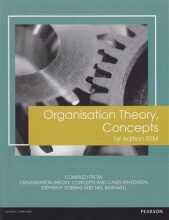Summary: Managing Organizational Change A Multiple Perspectives Approach | 9781259255113 | Ian Palmer, et al
- This + 400k other summaries
- A unique study and practice tool
- Never study anything twice again
- Get the grades you hope for
- 100% sure, 100% understanding
Read the summary and the most important questions on Managing Organizational Change A Multiple Perspectives Approach | 9781259255113 | Ian Palmer, Richard Dunford & David A. Buchanan
-
2 Images of Change Management
This is a preview. There are 1 more flashcards available for chapter 2
Show more cards here -
What is the Six-Images Framework?
To identify the images or mental models of organization and change Ian Palmer and Richard Dunford first identify two broad images of the task of managing which can be seen as either a controlling or as a shaping activity.
They then identify three broad images of change outcomes, which can be seen as intended, partially intended or unintended.
Controlling + intended = director
Controlling + partially intended = navigator
Controlling + unintended = caretaker
Shaping + intended = coach
Shaping + partially intended = interpreter
Shaping + unintended = nurturer -
What are controlling and shaping roles of change managers related to the Six-Images Framework?
Controlling is a top-down perspective, in this perspective the manager dictates what the change is going to look like.
Shaping is a bottom-up perspective, in this perspective the lower levels of the organisations have a say in what the change is going to look like. -
What are intended, partially intended and unintended change outcomes related to the Six-Images Framework?
Intended change outcomes, use of the assumption that intended change outcomes can be achieved as planned;
Partially intended change outcomes, use of the assumption that some, but not all, planned change outcomes are achievable;
Uninteded change outcomes, use of the assumption that manager often have great difficulty in achieving the change outcomes that were intended. -
What are the sets of considerations to make a conscious choice of the image-in-use of the Six-Images Framework?
Images-in-use depends on the type of change;
Images-in-use depends on the context of change;
Images-in-use depends on the phase of change;
Images-in-use depends on simultaneous involvement in multiple changes. -
3 Why Change? Contemporary Pressures and Drivers
-
What categories of pressures for change exist?
Environmental pressures for change such as:
Fashion;
Demography;
Mandate;
Reputation;
Hypercompetition;
Geopolitics.
Internal Organizational Change Drivers such as:
Growth;
Integration and collaboration;
Corporate identity;
A new CEO;
Power and politics. -
Why are not all organizations affected by equally by external pressures?
External threat can lead to rigidity rather than innovation;
A pressure for change has to be perceived and interpreted as such before action is triggered;
Even in the face of a clear need for change, forces for stability may interfere;
Management may decide to use buffering strategies to shield the organization from adaptive change. -
Why do organizations often fail to change following crises?
The cause of incidents are usually complex and systemic. Many organizations are good at passive learning (identifying lessons) but not so good at active learning (implementing those changes);
Most failures are treated as blameworthy, this is a barrier for active learning because managers experience more challenge and career rewards from implementing progressive change. -
Relate differing images of managing change to pressures for change.
The pressures for change are coloured by images that managers have of the change process. One manager's reaction to a particular external or internal pressure may not be shared by others. More successful change managers are likely to be those who have a clear, personal understanding about the pressures on them to change organisations, a well-developed rationale for what they are attempting to achieve, and a clear view of the likely effects of their actions. -
4 What to Change? A Diagnostic Approach
This is a preview. There are 2 more flashcards available for chapter 4
Show more cards here -
Why are different diagnostic models in planning organizational change used?
These models simplify complexity, highlight priorities, identify interdependencies, provide a common language, and offer a guide to the change implementation proces.
Models include:
Six-Box Organizational Model
7-s Framework
Star model
Four Frame model -
What models are used for strategic analysis?
Gap analysis
PESTLE Framework
Scenario planning
Elements of strategy
Strategic inventory
Cultural web
- Higher grades + faster learning
- Never study anything twice
- 100% sure, 100% understanding
































